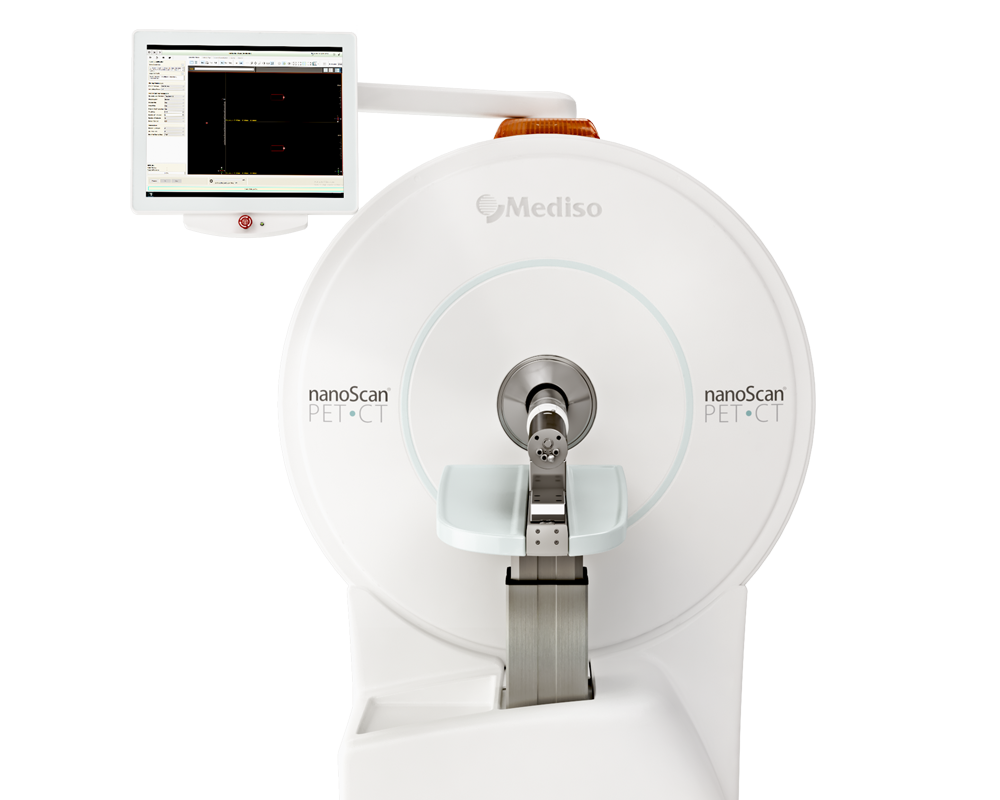Multiparametric Immunoimaging Maps Inflammatory Signatures in Murine Myocardial Infarction Models
2023.04.05.
Alexander Maier et al., JACC, 2023
Summary
Multiparametric PET imaging was used to assess post-infarction immune responses in murine models. Immune cell proliferation and metabolic activity were visualized using 18F-fluorothymidine and 18F-fluorodeoxyglucose. Immune cell migration was mapped with a CD11b-specific nanobody and a CCR2-binding PET probe. The imaging enabled non-invasive, longitudinal monitoring of inflammatory activity and atherosclerosis progression.
Results from nanoScan® PET/CT
Ten-week-old male C57BL/6J and eight-week-old male Apoe−/− mice were used; the latter were fed a Western diet for 10 weeks, and all procedures followed approved ethical guidelines.
Animals were anesthetized with 4% isoflurane for induction and 1% for maintenance prior to imaging, and a tail vein catheter was used to administer contrast agent at 0.5 mL/min. Whole-body CT imaging was performed with 50 kVp energy, 180 μAs current, and 0.25 mm³ isotropic voxel size, followed by PET acquisition filtered with a 400–600 keV energy window and reconstructed using CT-based attenuation correction. PET data were reconstructed using the TeraTomo3D algorithm (2 iterations, 6 subsets/iteration, 0.6 mm³ isotropic voxels).
Ischemia-reperfusion and permanent LAD occlusion result in distinct myocardial injury and cardiac function profiles
Two days after myocardial infarction, fasted C57BL/6 mice received 18F-FDG (340 ± 27.0 μCi in 100 μL PBS) via tail vein, followed by 30 minutes circulation and 30-minute PET imaging.
18F-FDG PET imaging showed significantly lower tracer uptake in the ischemic myocardium of mice with permanent LAD occlusion compared to ischemia-reperfusion mice, while higher uptake was observed in the remote myocardium of the permanent occlusion group, indicating compensatory metabolic activity. These differences were confirmed by both in vivo PET and ex vivo gamma counting.(Figure 1.)

Figure 1. 18F-FDG PET/CT performed two days post-surgery clearly identified infarct zones. PO mice showed lower uptake in the infarct area but higher uptake in remote myocardium compared to IR and control mice, indicating metabolic differences.
Ischemia severity correlates with immune cell accumulation in the infarcted myocardium
Two days after myocardial infarction, C57BL/6 mice were injected with 89Zr-labeled CD11b-specific nanobodies (200 ± 17.5 μCi in 100 μL PBS) and 64Cu-DOTA-ECL1i (354 ± 65.8 μCi in 100 μL PBS) via the tail vein. 89Zr PET imaging was performed 24 hours post-injection with a 30-minute acquisition time.
For 64Cu, a dynamic PET scan was initiated immediately after injection and covered the 0–60 minute time window.
PET imaging with 89Zr-labeled CD11b-specific nanobodies revealed a threefold increase in tracer uptake in the infarct zones of ischemia-reperfusion and permanent occlusion mice compared to controls. This elevated uptake indicated higher myeloid cell infiltration, which was confirmed by ex vivo gamma counting showing increased CD11b+ cell burden in the ischemic myocardium. The observed signal distribution was consistent with the expected localization of inflammatory leukocytes in infarcted tissue.
To assess inflammatory monocyte recruitment, 64Cu-DOTA-ECL1i PET imaging targeting CCR2 expression was performed in both myocardial infarction models. Elevated PET signal was detected in the infarct zones of mice with permanent coronary occlusion compared to control animals, reflecting increased CCR2-mediated monocyte infiltration. Furthermore, ex vivo gamma counting confirmed enhanced radiotracer accumulation in the ischemic myocardium of both infarction models, supporting the in vivo imaging findings.
Together, CD11b- and CCR2-targeted PET imaging provided complementary insights into the extent and nature of immune cell accumulation in the infarcted myocardium, highlighting distinct inflammatory profiles across models of varying ischemia severity. (Figure 2.)

Figure 2. PET/CT imaging showed increased 89Zr-CD11b and 64Cu-DOTA-ECL1i uptake in the infarcted hearts of IR and PO mice, confirming immune cell accumulation in ischemic regions.
Bone marrow responses are similar in ischemia-reperfusion and permanent occlusion
18F-Fluorothymidine was synthesized via nucleophilic substitution using 18F-fluoride, K₂CO₃, and MeCN, followed by reaction with protected thymidine in dry acetonitrile, and subsequent deprotection and neutralization. Two days post-myocardial infarction, mice received 382 ± 20.3 μCi 18F-FLT in 100 μL PBS via tail vein injection. The tracer was allowed to circulate for 90 minutes prior to 30-minute PET acquisition.
18F-FLT PET/CT imaging revealed increased proliferative activity in the bone marrow of both IR and PO mice two days after myocardial infarction, with no difference between the models. 18F-FDG PET/CT showed similarly elevated metabolic activity in the bone marrow in both groups. CD11b-targeted PET/CT performed three days post-infarction demonstrated reduced tracer uptake in the bone marrow of IR and PO mice, suggesting enhanced myeloid cell egress. In the spleen, 18F-FLT uptake was modestly elevated in PO mice, while 18F-FDG PET/CT showed no significant metabolic change. CD11b PET/CT revealed decreased signal in the spleen in both infarction models compared to controls, consistent with myeloid cell mobilization. (Figure 3.)

Figure 3. PET/CT imaging after infarction showed increased bone marrow activity and myeloid cell egress. 18F-FLT and 18F-FDG indicated elevated proliferation and metabolism, while reduced CD11b-PET/CT signal reflected cell mobilization.
Conclusion
Using the Mediso nanoScan® PET/CT system, radiotracers based on 89Zr, 64Cu, and 18F were successfully employed to investigate immune cell infiltration and activity following myocardial infarction. These tracers enabled precise and non-invasive monitoring of inflammatory processes in the heart, bone marrow, and spleen, revealing myeloid cell presence, inflammatory monocyte activity, as well as bone marrow proliferation and metabolic activity. These findings contribute to a better understanding of local and systemic inflammation.
Full article on jacc.org
How can we help you?
Don't hesitate to contact us for technical information or to find out more about our products and services.
Get in touch